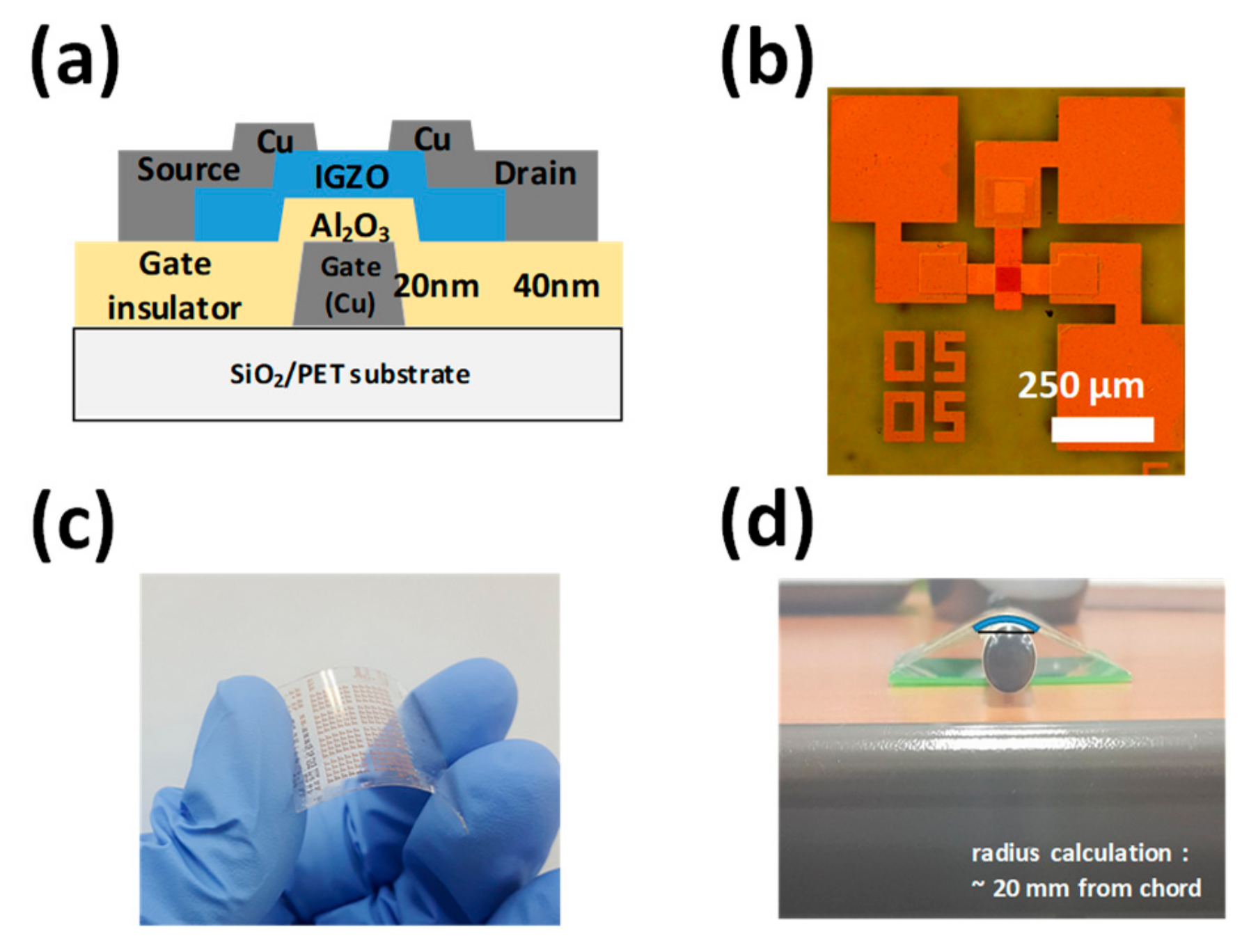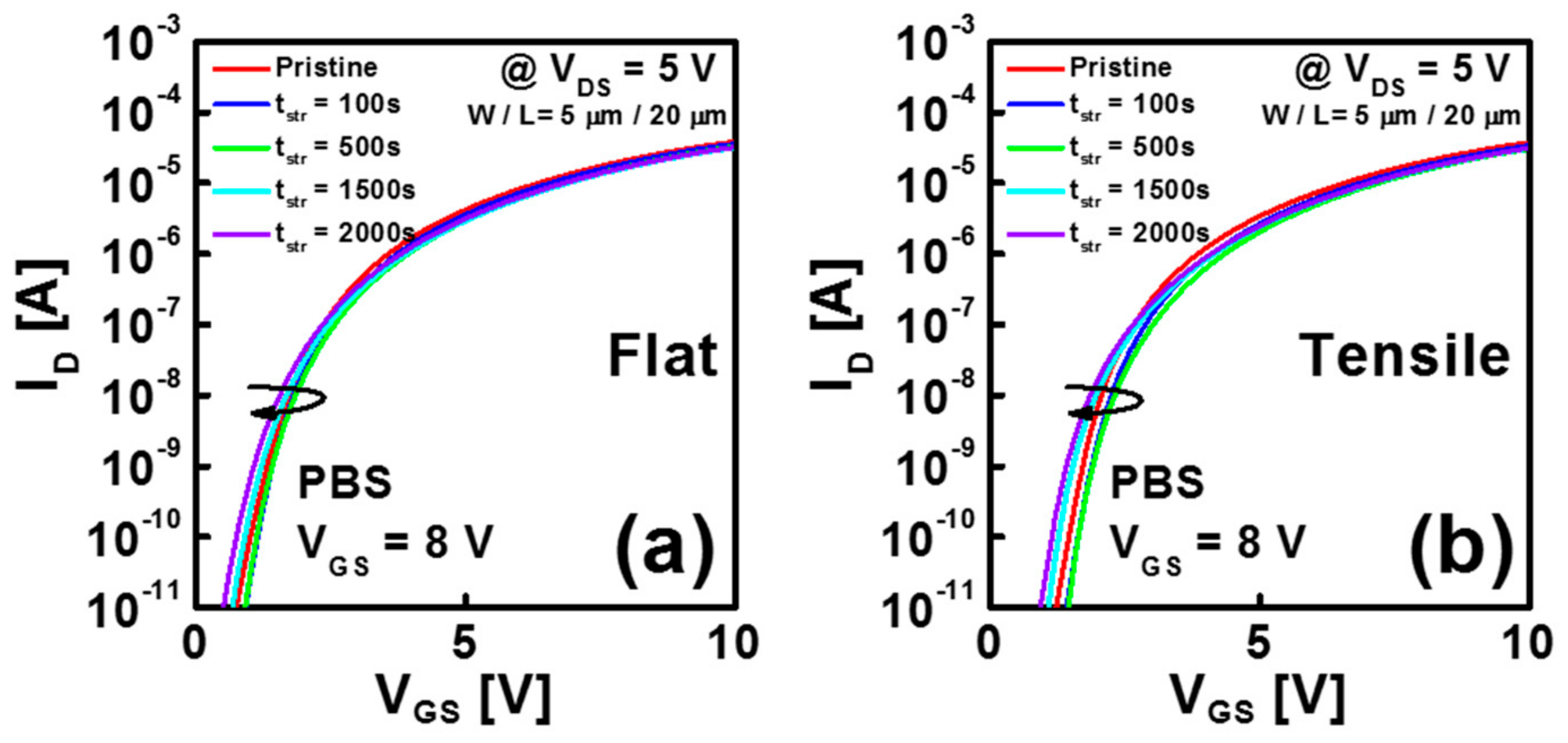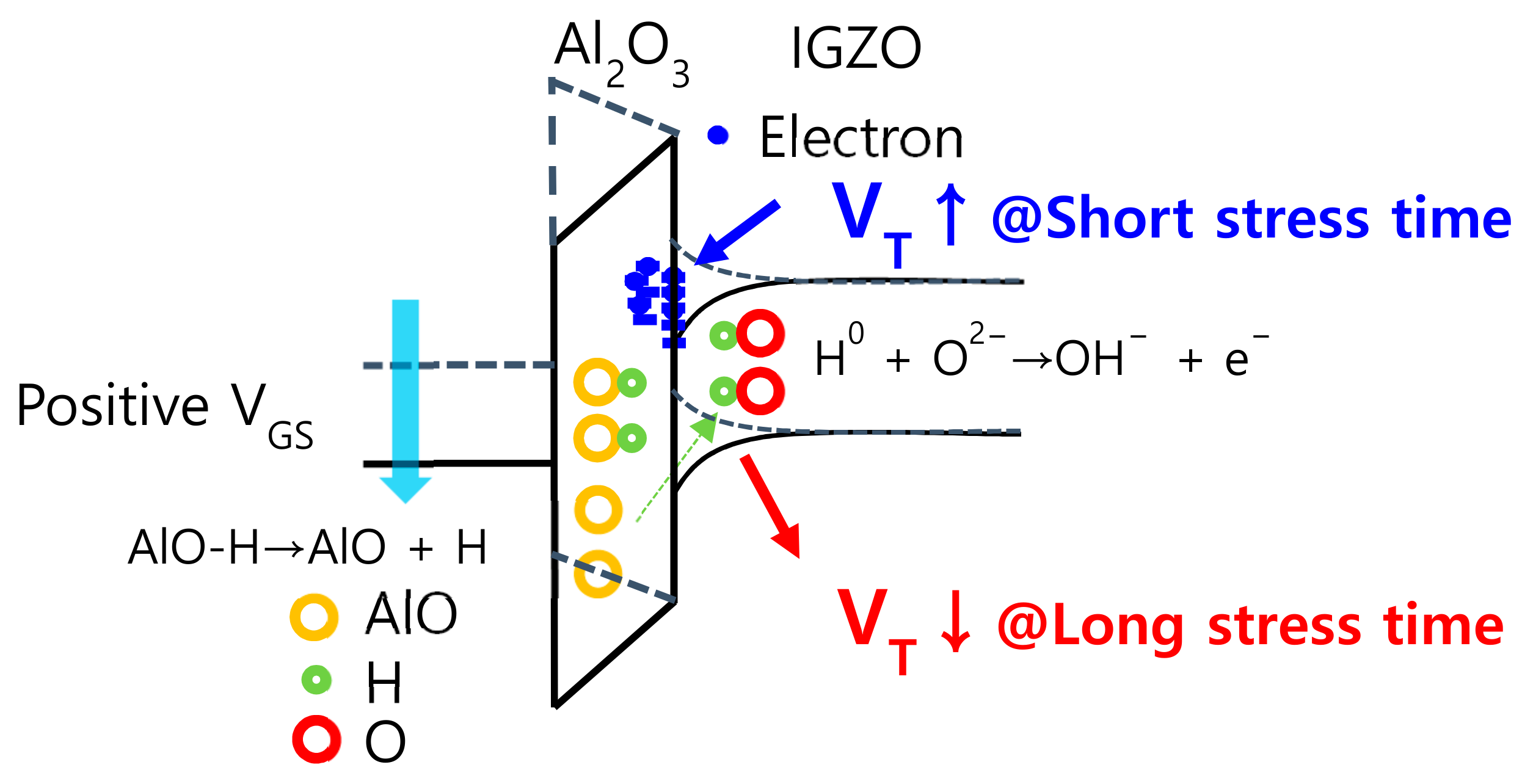Effect of Simultaneous Mechanical and Electrical Stress on the Electrical Performance of Flexible In-Ga-Zn-O Thin-Film Transistors
Abstract
:1. Introduction
2. Experimental Procedure
3. Results and Discussion
4. Conclusions
Author Contributions
Funding
Conflicts of Interest
References
- Nomura, K.; Ohta, H.; Takagi, A.; Kamiya, T.; Hirano, M.; Hosono, H. Room-temperature fabrication of transparent flexible thin-film transistors using amorphous oxide semiconductors. Nature 2004, 432, 488–492. [Google Scholar] [CrossRef] [PubMed]
- Geng, D.; Kang, D.H.; Jang, J. High.-performance amorphous Indium-Gallium-Zinc-Oxide thin-film transistor with a self-aligned etch stopper patterned by back-side UV exposure. IEEE Electron Device Lett. 2011, 32, 758–760. [Google Scholar] [CrossRef]
- Fortunato, E.; Barquinha, P.; Martins, R. Oxide semiconductor thin-film transistors: A review of recent advances. Adv. Mater. 2012, 24, 2945–2986. [Google Scholar] [CrossRef]
- Lee, U.G.; Mativeng, M.; Kang, D.H.; Jang, J. A Three-Mask-Processed Coplanar a-IGZO TFT with Source and Drain. Offsets. IEEE Electron Device Lett. 2012, 33, 812–814. [Google Scholar] [CrossRef]
- Zhang, J.; Yang, J.; Li, Y.; Wilson, J.; Ma, X.; Xin, Q.; Song, A. High performance complementary circuits based on p-SnO and n-IGZO thin-film transistors. Materials 2017, 10, 319. [Google Scholar] [CrossRef] [PubMed]
- Kim, K.S.; Ahn, C.H.; Kang, W.J.; Cho, S.W.; Jung, S.H.; Yoon, D.H.; Cho, H.K. An. all oxide-based imperceptible thin-film transistor with humidity sensing properties. Materials 2017, 10, 530. [Google Scholar] [CrossRef]
- Jeong, C.Y.; Kim, H.J.; Hong, S.Y.; Song, S.H.; Kwon, H.I. Two-stage unified stretched-exponential model for time-dependence of threshold voltage shift under positive-bias-stresses in amorphous indium–gallium–zinc oxide thin-film transistors. Jpn. J. Appl. Phys. 2017, 56, 080301. [Google Scholar] [CrossRef]
- Han, K.L.; Cho, H.S.; Ok, K.C.; Oh, S.; Park, J.S. Comparative Study on Hydrogen Behavior in InGaZnO Thin Film Transistors with a SiO2/SiNx/SiO2 Buffer on Polyimide and Glass Substrates. Electr. Mater. Lett. 2018, 14, 749–754. [Google Scholar] [CrossRef]
- Yoon, S.J.; Seong, N.J.; Choi, K.J.; Shin, W.C.; Yoon, S.M. Investigations on the bias temperature stabilities of oxide thin film transistors using In–Ga–Zn–O channels prepared by atomic layer deposition. RSC Adv. 2018, 8, 25014–25020. [Google Scholar] [CrossRef]
- Choi, S.B.; Kim, K.T.; Park, S.K.; Kim, Y.H. High-Mobility Inkjet-Printed Indium-Gallium-Zinc-Oxide Thin-Film Transistors Using Sr-Doped Al2O3 Gate Dielectric. Materials 2019, 12, 852. [Google Scholar] [Green Version]
- Hong, S.Y.; Kim, H.J.; Kim, D.H.; Jeong, H.Y.; Song, S.H.; Cho, I.T.; Noh, J.Y.; Yun, P.S.; Lee, S.W.; Park, K.S.; et al. Study on the Lateral Carrier Diffusion and Source-Drain. Series Resistance in Self-Aligned Top.-Gate Coplanar InGaZnO Thin-Film Transistors. Sci. Rep. 2019, 9, 6588. [Google Scholar] [CrossRef] [PubMed]
- Munzenrieder, N.; Voser, P.; Petti, L.; Zysset, C.; Buthe, L.; Vogt, C.; Salvatore, G.A.; Troster, G. Flexible Self-Aligned Double-Gate IGZO TFT. IEEE Electron Device Lett. 2014, 35, 69–71. [Google Scholar] [CrossRef]
- Kumaresan, Y.; Pak, Y.; Lim, N.; Kim, Y.; Park, M.J.; Yoon, S.M.; Youn, H.M.; Lee, H.; Lee, B.H.; Jung, G.Y. Highly Bendable In-Ga-ZnO Thin Film Transistors by Using a Thermally Stable Organic Dielectric Layer. Sci. Rep. 2016, 6, 37764. [Google Scholar] [CrossRef]
- Yao, R.; Zheng, Z.; Xiong, M.; Zhang, X.; Li, X.; Ning, H.; Fang, Z.; Xie, W.; Lu, X.; Peng, J. Low-temperature fabrication of sputtered high-k HfO2 gate dielectric for flexible a-IGZO thin film transistors. Appl. Phys. Lett. 2018, 112, 103503. [Google Scholar] [CrossRef]
- Jang, H.W.; Kim, H.R.; Yang, J.H.; Byun, C.W.; Kang, C.S.; Kim, S.K.; Yoon, S.M. Stability improvements of InGaZnO thin-film transistors on polyimide substrates with Al2O3 buffer layer. Jpn. J. Appl. Phys. 2018, 57, 090313. [Google Scholar] [CrossRef]
- Zhang, L.; Xiao, W.; Wu, W.; Liu, B. Research Progress on Flexible Oxide-Based Thin Film Transistors. App. Sci. 2019, 9, 773. [Google Scholar] [CrossRef]
- Fujii, M.; Uraoka, Y.; Fuyuki, T.; Jung, J.S.; Kwon, J.Y. Experimental and Theoretical Analysis of Degradation in Ga2O3–In2O3–ZnO Thin-Film Transistors. Jpn. J. Appl. Phys. 2009, 48, 04C091. [Google Scholar] [CrossRef]
- Lee, S.W.; Jeon, K.C.; Park, J.-H.; Kim, S.C.; Kong, D.S. Electrical stress-induced instability of amorphous indium-gallium-zinc oxide thin-film transistors under bipolar ac stress. Appl. Phys. Lett. 2009, 95, 132101. [Google Scholar] [CrossRef]
- Mativenga, M.; Seok, M.J.; Jang, J. Gate bias-stress induced hump-effect in transfer characteristics of amorphous-indium-galium-zinc-oxide thin-fim transistors with various channel widths. Appl. Phys. Lett. 2011, 99, 122107. [Google Scholar] [CrossRef]
- Liao, P.Y.; Chang, T.C.; Su, W.C.; Chen, Y.J.; Chen, B.W.; Hsieh, T.Y.; Yang, C.Y.; Huang, Y.Y.; Chang, H.M.; Chiang, S.C. Effect of mechanical-strain-induced defect generation on the performance of flexible amorphous In–Ga–Zn–O thin-film transistors. Appl. Phys. Exp. 2016, 9, 124101. [Google Scholar] [CrossRef]
- Billah, M.M.; Hasan, M.M.; Jang, J. Effect of Tensile and Compressive Bending Stress on Electrical Performance of Flexible a-IGZO TFTs. IEEE Electron Device Lett. 2017, 38, 890–893. [Google Scholar] [CrossRef]
- Jeong, H.J.; Kim, B.S.; Han, K.L.; Oh, S.; Park, J.S. Quantitative analysis of interface trap recovery caused by repetitive bending stress in flexible oxide thin-film transistors. Jpn. J. Appl. Phys. 2019, 58, 050906. [Google Scholar] [CrossRef]
- Lee, W.-S.; Mativenga, M.; Kang, J.-S.; Tak, N.-K.; Choi, I.-C.; Kim, J.-Y.; Han, J.-U.; Choi, J.-H.; Hwang, M.-G. Spice model for detection of dynamic threshold voltage shift during failure analysis of oxide TFT-based AMD gate drivers. J. Soc. Inf. Display 2017, 25, 663–671. [Google Scholar] [CrossRef]
- Kim, W.-S.; Lee, Y.-H.; Cho, Y.-J.; Kim, B.-K.; Park, K.T.; Kim, O. Effect of Wavelength and Intensity of Light on a-InGaZnO TFTs under Negative Bias Illumination Stress. ECS J. Solid State Sci. Technol. 2017, 6, Q6–Q9. [Google Scholar] [CrossRef]
- Jeong, J.K.; Yang, H.W.; Jeong, J.H.; Mo, Y.-G.; Kim, H.D. Origin of threshold voltage instability in indium-gallium-zinc oxide thin film transistors. Appl. Phys. Lett. 2008, 93, 123508. [Google Scholar] [CrossRef]
- Jeong, H.-S.; Park, M.-J.; Kwon, S.-H.; Joo, H.-J.; Kwon, H.-I. Highly sensitive and selective room-temperature NO2 gas-sensing characteristics of SnOX-based p-type thin-film transistor. Sens. Actuators B Chem. 2019, 288, 625–633. [Google Scholar] [CrossRef]
- Jeong, H.J.; Han, K.L.; Ok, K.C.; Lee, H.M.; Oh, S.; Park, J.S. Effect of mechanical stress on the stability of flexible InGaZnO thin-film transistors. J. Inf. Disp. 2017, 18, 87–91. [Google Scholar] [CrossRef] [Green Version]
- Chang, Y.H.; Yu, M.J.; Lin, R.P.; Hsu, C.P.; Hou, T.H. Abnormal positive bias stress instability of In–Ga–Zn–O thin-film transistors with low-temperature Al2O3 gate dielectric. Appl. Phys. Lett. 2016, 108, 033502. [Google Scholar] [CrossRef]
- Dillon, A.C.; Ott, A.W.; Way, J.D.; George, S.M. Surface chemistry of Al2O3 deposition using Al(CH3)3 and H2O in a binary reaction sequence. Surf. Sci. 1995, 322, 230–242. [Google Scholar] [CrossRef]
- Kamiya, T.; Nomura, K.; Hosono, H. Origins of High. Mobility and Low Operation Voltage of Amorphous Oxide TFTs: Electronic Structure, Electron. Transport Defects and Doping. J. Disp. Tech. J. Disp. Technol. 2009, 5, 468–483. [Google Scholar] [CrossRef]
- Bae, H.; Choi, H.; Jun, S.; Jo, C.; Kim, Y.H.; Hwang, J.S.; Ahn, J.; Oh, S.; Bae, J.-U.; Choi, S.-J.; et al. Single-scan monochromatic photonic capacitance-voltage technique for extraction of subgap DOS over the bandgap in amorphous semiconductor TFTs. IEEE Electron Dev. Lett. 2013, 34, 1524–1526. [Google Scholar] [CrossRef]
- Lee, J.M.; Cho, I.T.; Lee, J.H.; Kwon, H.I. Bias-stress-induced stretched-exponential time dependence of threshold voltage shift in InGaZnO thin film transistors. Appl. Phys. Lett. 2008, 93, 093504. [Google Scholar] [CrossRef]
- Migliorato, P.; Chowdhury, M.D.H.; Um, J.G.; Seok, M.J.; Jang, J. Light/negative bias stress instabilities in indium gallium zinc oxide thin film transistors explained by creation of a double donor. Appl. Phys. Lett. 2012, 101, 123502. [Google Scholar] [CrossRef]
- Revenant, C.; Benwadih, M.; Proux, O. Local structure around Zn and Ga in solution-processed In-Ga-Zn-O and implications for electronic properties. Phys. Status Solidi RRL 2015, 9, 652–655. [Google Scholar] [CrossRef]







© 2019 by the authors. Licensee MDPI, Basel, Switzerland. This article is an open access article distributed under the terms and conditions of the Creative Commons Attribution (CC BY) license (http://creativecommons.org/licenses/by/4.0/).
Share and Cite
Seo, Y.; Jeong, H.-S.; Jeong, H.-Y.; Park, S.; Jang, J.T.; Choi, S.; Kim, D.M.; Choi, S.-J.; Jin, X.; Kwon, H.-I.; et al. Effect of Simultaneous Mechanical and Electrical Stress on the Electrical Performance of Flexible In-Ga-Zn-O Thin-Film Transistors. Materials 2019, 12, 3248. https://doi.org/10.3390/ma12193248
Seo Y, Jeong H-S, Jeong H-Y, Park S, Jang JT, Choi S, Kim DM, Choi S-J, Jin X, Kwon H-I, et al. Effect of Simultaneous Mechanical and Electrical Stress on the Electrical Performance of Flexible In-Ga-Zn-O Thin-Film Transistors. Materials. 2019; 12(19):3248. https://doi.org/10.3390/ma12193248
Chicago/Turabian StyleSeo, Youngjin, Hwan-Seok Jeong, Ha-Yun Jeong, Shinyoung Park, Jun Tae Jang, Sungju Choi, Dong Myong Kim, Sung-Jin Choi, Xiaoshi Jin, Hyuck-In Kwon, and et al. 2019. "Effect of Simultaneous Mechanical and Electrical Stress on the Electrical Performance of Flexible In-Ga-Zn-O Thin-Film Transistors" Materials 12, no. 19: 3248. https://doi.org/10.3390/ma12193248




